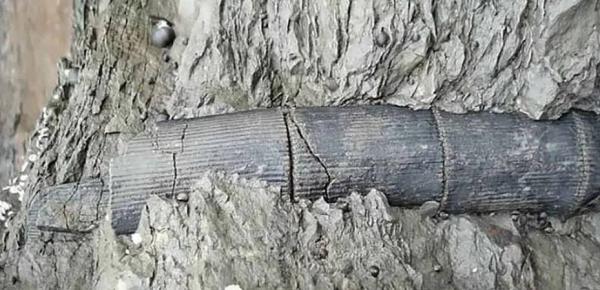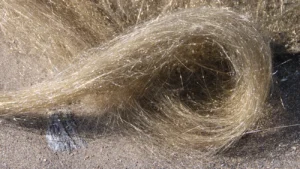In China’s largest province, Qinghai, there’s something a little out of place. A set of modern-looking, metallic pipes protrudes from a mountainside, accompanied by a monument dedicated to the extraterrestrials who supposedly placed them there. Hardly. But what kind of natural phenomenon are these strange Baigong Pipes?
Ad usual with anything both intriguing and difficult to explain, the internet is awash with AI pictures of the Baigong Pipes, blurry photos from the 1990s, and inconsistent stories and “facts.” Some sources claim that the pipes were discovered by a local journalist, while others report that a group of American scientists found them while searching for dinosaur bones. A few sources state that the pipes are in a pyramid-like structure, while others say they are in a cave. Real images of the pipes are hard to verify.
Characteristics
So, what do we know? The Baigong Pipes are located approximately 40 kilomters from the nearest town — Delingha City — in Qinghai. This is part of the wider Haixi Mongolian and Tibetan Autonomous Prefecture. It’s a remote area with no residents or modern industry.
Chinese news outlet Xinhuanet described the unusual pipes in an article from June 2002:
This cave is about 6m in depth. Inside, there is a half pipe about 40cm in diameter, tilting from the top to the inner end of the cave. Another pipe of the same diameter goes into the earth with only its top visible above the ground. Above the cave are a dozen pipes of various diameters that run into the mountain. All the pipes are red-brownish, the same color as that of the surrounding rocks.
One version of the pipes’ discovery story involves a Chinese author named Bai Yu, who found them while exploring the caves at Mount Baigong in 1996. He believed that one of the caves looked like humans had carved it out. Upon entering its triangular archway, he found rusty-looking pipes sticking out from the floor and the walls. Outside the cave was a salt lake, which also had these pipes sticking out from the sand on the shore.

Supposed photo of one of the Pipes. Photo: Atlas Obscura
Bai Yu sent physical samples of the pipes to China’s Ministry of Metallurgical Industry (which no longer exists) for analysis. What they found was extraordinary; The pipes were 92% calcium oxide, silicon dioxide, and ferric oxide, while the remaining 8% was inconclusive or unknown.
Later on, the Beijing Institute of Geology determined the possible age of the pipes using thermo-luminescence dating. This method can determine the age of crystalline minerals by exposing them to sunlight or heat. They found that the sample was approximately 150,000 years old. Because the pipes were high in iron and other metals, and human activity in the area dates back only 30,000 years, some people have suggested that the pipes could be of extraterrestrial origin. The government hurriedly turned the Baigong Pipes into a tourist attraction. If you’re driving along the highway, you’ll find an alien monument pointing the way.
Search for the truth
Follow-up investigations by Chinese researchers aimed to debunk the ET theory. There had to be a natural explanation.
One natural theory involves tectonic activity. The Qinghai Province sits on the Tibetan Plateau, a vast region with a tumultuous geological history where the Indo-Australian Plate and Eurasian Plates collide. This created the mountain ranges we know today, as well as deep chasms that trapped iron-rich magma. When solidified, the magma can appear like rusty iron tubes.
A variant of this theory suggests not volcanism but flooding. Because the Tibetan Plateau possesses high concentrations of iron and iron oxides in the soil, the iron may mix with other substances to create a thick “pipe” in cracks in the ground.
Fossilized plants?
A Chinese news outlet called the Xinmin Weekly published an updated story on the Baigong Pipes in 2003. They quoted scientists who confirmed the presence of plant material in the pipes. When cut open, the pipes exhibited features resembling tree rings.
This suggests the pipes were simply petrified trees. These form when sediment or volcanic ash buries a tree, cutting off the tree’s oxygen and slowing decay. Over millions of years, groundwater enriched by minerals such as silica, calcite, or pyrite seeps through the wood’s pores. As the organic material slowly decomposes, these minerals creep in to replace the wood’s cells. Eventually, the minerals turn to stone.

These pipes also occur in North America. Photo: Xa Luan
Another theory is that the pipes are sediment that has turned into rock in a process called diagenesis. Diagenesis occurs when layers of sediment build up, squeezing out water, and the weight of the material above compacts it. At the same time, cementation occurs when minerals like silica, calcite, or iron oxides dissolve in groundwater and bind the sediment particles together. The result is iron-rich rocks resembling iron pipes.
A winner
So which theory is most likely to be correct? We may finally have an answer, thanks to a study conducted by the American researchers Joann Mossa and B. A. Schumacher. They studied similar pipes found in southern Louisiana.
“We studied the morphology, mineralogy, and physical and chemical properties of the cylinders…The cylinders are inferred to be tap-root casts of fossil trees in which sediments replaced wood, and pedagogic and diagenetic processes caused the external form of the tree root to be preserved while the internal structure was lost,” Mossa and Schumacher concluded.






